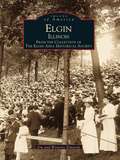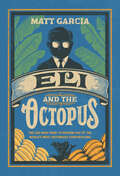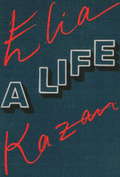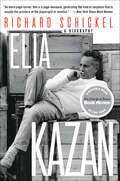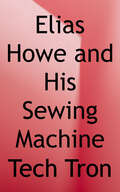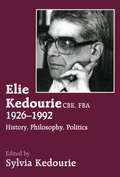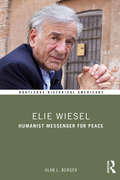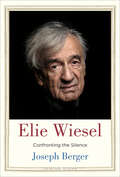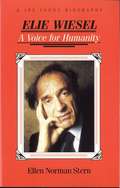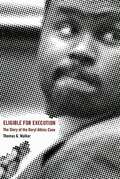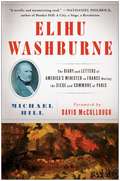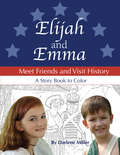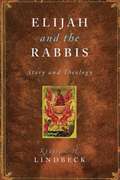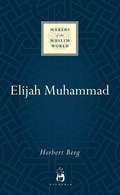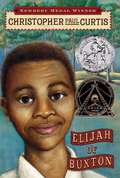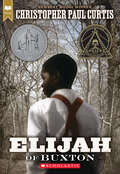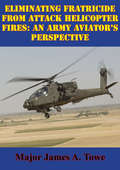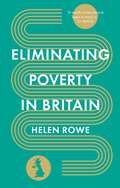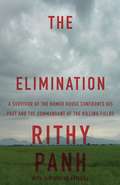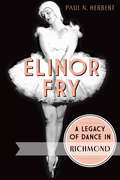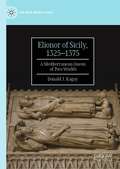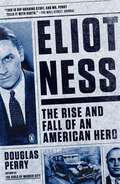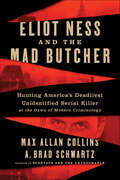- Table View
- List View
Elgin, Illinois: From the Collection of the Elgin Area Historical Society
by Wynette Edwards Jim EdwardsElgin was named by a city founder, James T. Gifford, after his favorite hymn. The city shares its name with 20 cities in 15 states and 8 countries. Elgin is situated on the banks of the Fox River, 35 milesnorthwest of Chicago, the city with which Elgin had thriving business exchanges in agricultural and industrial goods. The city's world-wide fame, for the most part, has come from its watch factory and Mr. Gail Borden's milk company. Pianos, shoes, books, and even chewing gum were also manufactured in Elgin and sold internationally. This exciting new study of a major Midwestern city is chock-full of images, many of which have never before been published. Featured in Elgin, Illinois is information about the Elgin National Watch Company, early circus and carnival attractions, as well as rip-roaring national road races. Highlighted in one chapter is Elgin's part in helping to win World War Iat home, complete with original photographs from the front in Europe. This lively and historical look at Elgin from the 1800s to the 1930s is interwoven with national and international trends and events.
Eli and the Octopus: The CEO Who Tried to Reform One of the World’s Most Notorious Corporations
by Matt GarciaThe poignant rise and fall of an idealistic immigrant who, as CEO of a major conglomerate, tried to change the way America did business before he himself was swallowed up by corporate corruption.At 8 a.m. on February 3, 1975, Eli Black leapt to his death from the 44th floor of Manhattan’s Pan Am building. The immigrant-turned-CEO of United Brands—formerly United Fruit, now Chiquita—Black seemed an embodiment of the American dream. United Brands was transformed under his leadership—from the “octopus,” a nickname that captured the corrupt power the company had held over Latin American governments, to “the most socially conscious company in the hemisphere,” according to a well-placed commentator. How did it all go wrong?Eli and the Octopus traces the rise and fall of an enigmatic business leader and his influence on the nascent project of corporate social responsibility. Born Menashe Elihu Blachowitz in Lublin, Poland, Black arrived in New York at the age of three and became a rabbi before entering the business world. Driven by the moral tenets of his faith, he charted a new course in industries known for poor treatment of workers, partnering with labor leaders like Cesar Chavez to improve conditions. But risky investments, economic recession, and a costly wave of natural disasters led Black away from the path of reform and toward corrupt backroom dealing.Now, two decades after Google’s embrace of “Don’t be evil” as its unofficial motto, debates about “ethical capitalism” are more heated than ever. Matt Garcia presents an unvarnished portrait of Black’s complicated legacy. Exploring the limits of corporate social responsibility on American life, Eli and the Octopus offers pointed lessons for those who hope to do good while doing business.
Elia Kazan: A Life
by Elia Kazan"This is the best autobiography I've read by a prominent American in I don't know how many years. It is endlessly absorbing and I believe this is because it concerns a man who is looking to find a coherent philosophy that will be tough enough to contain all that is ugly in his person and his experience, yet shall prove sufficiently compassionate to give honest judgment on himself and others. Somehow, the author brings this off. Elia Kazan: A Life has that candor of confession which is possible only when the deepest wounds have healed and honesty can achieve what honesty so rarely arrives at--a rich and hearty flavor. By such means, a famous director has written a book that offers the kind of human wealth we find in a major novel." --Norman Mailer. In this amazing autobiography, Kazan at seventy-eight brings to the undiluted telling of his story--and revelation of himself--all the passion, vitality, and truth, the almost outrageous honesty, that have made him so formidable a stage director (A Streetcar Named Desire, Death of a Salesman, All My Sons, Cat on a Hot Tin Roof, Tea and Sympathy), film director (On the Waterfront, East of Eden, Gentleman's Agreement, Splendor in the Grass, Baby Doll, The Last Tycoon, A Face in the Crowd), and novelist (the number-one best-seller The Arrangement.) Kazan gives us his sense of himself as an outsider (a Greek rug merchant's son born in Turkey, an immigrant's son raised in New York and educated at Williams College). He takes us into the almost accidental sojourn at the Yale Drama School that triggered his commitment to theatre, and his edgy, exciting apprenticeship with the new and astonishing Group Theatre, as stagehand and stage manager--and as actor (Waiting for Lefty, Golden Boy) ... his first nervous and then successful attempts at directing for theatre and movies (The Skin of Our Teeth, A Tree Grows in Brooklyn) ... his return to New York to co-found the Actors Studio (and his long and ambivalent relationship with Lee Strasberg) ... his emergence as premier director on both coasts. With his director's eye for the telling scene, Kazan shares the joys and complications of production, his unique insights on acting, directing, and producing. He makes us feel the close presence of the actors, producers, and writers he's worked with--James Dean, Marlon Brando, Tennessee Williams, Vivien Leigh, Tallulah Bankhead, Sam Spiegel, Darryl Zanuck, Harold Clurman, Arthur Miller, Budd Schulberg, James Baldwin, Clifford Odets, and John Steinbeck among them. He gives us a frank and affectionate portrait of Marilyn Monroe. He talks with startling candor about himself as husband and--in the years where he obsessively sought adventure outside marriage--as lover. For the first time, he discusses his Communist Party years and his wrenching decision in 1952 to be a cooperative witness before HUAC. He writes about his birth as a writer. The pace and organic drama of his narrative, his grasp of the life and politics of Broadway and Hollywood, the keenness with which he observes the men and women and worlds around him, and, above all, the honest with which he pursues and captures his own essence, make this one of the most fascinating autobiographies of our time.
Elia Kazan: A Biography
by Richard SchickelFew figures in film and theater history tower like Elia Kazan. Born in 1909 to Greek parents in Istanbul, Turkey, he arrived in America with incomparable vision and drive, and by the 1950s he was the most important and influential director in the nation, simultaneously dominating both theater and film. His productions of A Streetcar Named Desire and Death of a Salesman reshaped the values of the stage. His films -- most notably On the Waterfront -- brought a new realism and a new intensity of performance to the movies. Kazan's career spanned times of enormous change in his adopted country, and his work affiliated him with many of America's great artistic moments and figures, from New York City's Group Theatre of the 1930s to the rebellious forefront of 1950s Hollywood; from Katharine Hepburn and Spencer Tracy to Marlon Brando and James Dean.Ebullient and secretive, bold and self-doubting, beloved yet reviled for "naming names" before the House Un-American Activities Committee, Kazan was an individual as complex and fascinating as any he directed. He has long deserved a biography as shrewd and sympathetic as this one.In the electrifying Elia Kazan, noted film historian and critic Richard Schickel illuminates much more than a single astonishing life and life's work: He pays discerning tribute to the power of theater and film, and casts a new light on six crucial decades of American history.
Elias Howe and His Sewing Machine: U. S. Economy in the Mid-1800s (Children's Computers and Technology Books)
by Tech TronIn this book, you will read about Elias Howe and his invention of the sewing machine. Discuss how his invention helped the economic growth in the Northeast states in the mid-1800s. Read about Elias' history and why his sewing machine was the first of its kind. How was his invention received by the general public? Read to learn more about the topic. Grab a copy today.
Elie Kedourie, CBE, FBA 1926-1992: History, Philosophy, Politics
by Sylvia KedourieThis title is a collection of essays evaluating Elie Kedourie's work and his legacy to scholarship. Of his own work, three pieces are included, and one of his essays: "The Jews of Babylon and Baghdad" is published here for the first time.
Elie Wiesel: Humanist Messenger for Peace (Routledge Historical Americans)
by Alan L. BergerElie Wiesel: Humanist Messenger for Peace is part biography and part moral history of the intellectual and spiritual journey of Elie Wiesel, a Holocaust survivor, human rights activist, author, university professor, and Nobel Peace Prize winner. In this concise text, Alan L. Berger portrays Wiesel’s transformation from a pre-Holocaust, deeply God-fearing youth to a survivor of the Shoah who was left with questions for both God and man. An advisor to American presidents of both political parties, his nearly 60 books voiced an activism on behalf of oppressed people everywhere. The book illuminates Wiesel’s contributions in the areas of religion, human rights, literature, and Jewish thought to show the impact that he has had on American life. Supported by primary documents about and from Wiesel, the volume gives students a gateway to explore Wiesel’s incredible life. This book will make a great addition to courses on American religious or intellectual thought.
Elie Wiesel: Confronting the Silence (Jewish Lives)
by Joseph BergerAn intimate look at Elie Wiesel, author of the seminal Holocaust memoir Night and recipient of the Nobel Peace Prize As an orphaned survivor and witness to the horrors of Auschwitz, Elie Wiesel (1928–2016) compelled the world to confront the Holocaust with his searing memoir Night. How did this soft-spoken man from a small Carpathian town become such an influential figure on the world stage? Drawing on Wiesel’s prodigious literary output and interviews with his family, friends, scholars, and critics, Joseph Berger seeks to answer this question. Berger explores Wiesel’s Hasidic childhood in Sighet, his postwar years spent rebuilding his life from the ashes in France, his transformation into a Parisian intellectual, his failed attempts at romance, his years scraping together a living in America as a journalist, his decision to marry and have a child, his emergence as a spokesperson for Holocaust survivors and persecuted peoples throughout the world, his lifelong devotion to the state of Israel, and his difficult final years. Through this penetrating portrait we come to know intimately the man the Norwegian Nobel Committee called “a messenger to mankind.&rdquo
Elie Wiesel
by Ellen N. SternFew Holocaust survivors have gained the recognition and honour as Elie Wiesel has as an author, journalist and lecturer. In this latest biography Ellen Stern chronicles the remarkable life of Elie Wiesel.
Eligible for Execution: The Story of the Daryl Atkins Case
by Thomas G. Walker"There is no more abhorrent and devastating crime than one human being taking the life of another. When government responds by seeking to execute an individual convicted of homicide, it is imposing the most grim and terrifying power a state can exercise over one of its own citizens. And when a juror casts a life or death vote in a capital case, he or she is engag¬ing in perhaps the gravest and most disquieting act of civic responsibility. This book examines the decision of the U.S. Supreme Court in the case of Atkins v. Virginia It is the story of Daryl Atkins, who at the age of eighteen participated in a tragic and senseless murder. It is also the story of the victim of that crime, Eric Nesbitt, a young man serving in the U.S. Air Force. The book follows the Atkins case from commission of the crime through the Supreme Court's ruling and its aftermath." -Preface
Elihu Washburne: The Diary and Letters of America's Minister to France During the Siege and Commune of Paris
by David Mccullough Michael HillThis is the remarkable and inspiring story--told largely in his own words-- of American diplomat Elihu Washburne, who heroically aided his countrymen and other foreign nationals when Paris was devastated by war and revolutionin1870-71. Elihu Washburne rose from a hardscrabble existence in New England and the Midwest to become a congressman and diplomat. A confidante of Lincoln and Grant during the Civil War, Washburne was appointed Minister to France by Grant in 1869, arriving in Europe shortly before the outbreak of the Franco- Prussian War. When Bismarck ordered the Prussian army to lay siege to Paris, intent on forcing the French to surrender, Minister Washburne--alone among major power diplomats--remained at his post, determined to protect Americans and German nationals trapped in Paris. After the French capitulation, new horrors struck Paris. The government was toppled by a band of violent revolutionaries, known as the Commune, who embarked on a reign of terror that filled the streets with blood. Once again, Washburne stepped forward to help wherever he could until the Commune collapsed and its bloody orgy ended. During his ordeal Washburne endured cannon bombardments, brutally cold weather, dwindling food supplies, bouts of ill health, and long separations from his family. He witnessed the plight of starving women and children, riots in the streets, senseless executions, and countless acts of unspeakable violence and bloodshed. In the midst of it all, Washburne kept a remarkable personal diary that chronicled the monumental events swirling about him. He knew he was at the center of history and was determined to record what he saw. The diary--and letters he wrote to family and officials in Washington--provides a vivid personal account of life during some of Paris's darkest days. Filled with political and military insight, Washburne's writings also have an unmistakable charm, at times blending homespun expressions with quotations from Shakespeare and the Bible. Michael Hill provides essential background information and historical context to the excerpts from Washburne's diary and letters, which are drawn from the original manuscript sources and collected into one volume for the first time. Through his own words, we come to know and admire Washburne as he struggles to stay alive, perform his duty, and not let his country down. The story of Elihu Washburne is a great American story--the tale of an American hero rising to greatness in the midst of difficult and extraordinary times.
Elijah and Emma Meet Friends and Visit History: A Story Book to Color
by Darlene MillerInstead of sitting in a classroom, Elijah likes to “do stuff.” His grandmother helps the family to participate in reenactments and living history events where he, and his sister Emily, can experience the life styles of early America and the Civil War era. “To read about the reenactment of history is fascinating, to color the pages is to bring the story to life. Elijah and Emma Meet Friends and Visit History is truly one of a kind encouraging people of all ages to seek out reenactments and places of historical value. Elijah and Emma Meet Friends and Visit History could only become priceless as the years pass.” Joan Pomeroy Author
Elijah and the Rabbis: Story and Theology
by Lindbeck Kristen H.Through an innovative synthesis of narrative critique, oral-formulaic study, folkloric research, and literary analysis, Kristen H. Lindbeck reads all the Elijah narratives in the Babylonian Talmud and details the rise of a distinct, quasi-angelic figure who takes pleasure in ordinary interaction.
Elijah and the Rabbis: Story and Theology
by Kristen LindbeckThrough an innovative synthesis of narrative critique, oral-formulaic study, folkloric research, and literary analysis, Kristen H. Lindbeck reads all the Elijah narratives in the Babylonian Talmud and details the rise of a distinct, quasi-angelic figure who takes pleasure in ordinary interaction. During the Talmudic period of 50-500 C.E., Elijah developed into a recognizable character quite different from the Elijah of the Bible. The Elijah of the Talmud dispenses wisdom, advice, and, like the Elijah of Jewish folklore, helps people directly, even with material gifts. Lindbeck highlights particular features of the Elijah stories, allowing them to be grouped into generic categories and considered alongside Rabbinic literary motifs and non-Jewish traditions of late antiquity. She compares Elijah in the Babylonian Talmud to a range of characters-angels, rabbis, wonder-workers, the angel of death, Christian saints, and even the Greek god Hermes. She concludes with a survey of Elijah's diverse roles from medieval times to today, throwing into brilliant relief the complex relationship between ancient Elijah traditions and later folktales and liturgy that show Elijah bringing benefits and blessings, appearing at circumcisions and Passover, and visiting households after the Sabbath.
Elijah Muhammad (Makers of the Muslim World)
by Herbert BergIn the mid-1930s, Elijah Muhammad was just one of several competing leaders of the embryonic movement begun by the mysterious Wali Fard Muhammad, who claimed to be a prophet of Islam and who had recently disappeared. By the time of his death in 1975, Elijah Muhammad led a movement that may have numbered a few hundred thousand, making him the most powerful Muslim in the United States of America. Even before his death he was overshadowed by the growing legend of Malcolm X, and after his death by the activities of Louis Farrakhan and his own son Warith Deen Mohammed. Each of these men, however, was brought to Islam by Elijah Muhammad. And although Malcolm X and Elijah Muhammad's son came to reject his idiosyncratic and racial formulation of Islam, Elijah Muhammad was responsible for introducing hundreds of thousands, perhaps even millions of African Americans to Islam. Almost four decades after his death, he remains by far the most influential American Muslim.
Elijah of Buxton
by Christopher Paul Curtis11-year-old Elijah is the first child born into freedom in Buxton, Canada, a settlement of runaway slaves just over the border from Detroit. Things change when a former slave steals money from Elijah's friend, who has been saving to buy his family out of slavery in the South. Elijah embarks on a dangerous journey to America in pursuit of the thief. <P><P> <b>A Newbery Honor book</b> <P><b>Winner of the Coretta Scott King Medal</b> <P><b> Winner of the Scott O'Dell Award for Historical Fiction </b>
Elijah of Buxton
by Christopher Paul CurtisMaster storyteller Christopher Paul Curtis's Newbery Honor novel, featuring his trademark humor, unique narrative voice, and new cover art--now in paperback!<P><P> Eleven-year-old Elijah lives in Buxton, Canada, a settlement of runaway slaves near the American border. He's the first child in town to be born free, and he ought to be famous just for that. Unfortunately, all that most people see is a "fra-gile" boy who's scared of snakes and talks too much. But everything changes when a former slave steals money from Elijah's friend, who has been saving to buy his family out of captivity in the South. Now it's up to Elijah to track down the thief--and his dangerous journey just might make a hero out of him, if only he can find the courage to get back home.<P> <i>Advisory: Bookshare has learned that this book offers only partial accessibility. We have kept it in the collection because it is useful for some of our members. To explore further access options with us, please contact us through the Book Quality link on the right sidebar. Benetech is actively working on projects to improve accessibility issues such as these. </i>
Eliminating Fratricide From Attack Helicopter Fires: An Army Aviator's Perspective
by Major James A. ToweIn the aftermath of the euphoria brought on by our military victory in the Persian Gulf War, is the realization that we still have much to learn. The Persian Gulf War appears to have validated the quality of U.S. doctrine, leadership and military prowess. It showcased the technical superiority of our equipment, and confirmed under fire the courage and competence of our soldiers, sailors, airmen, and marines. Yet, even in an overwhelming victory there are painfully hard lessons to be learned, or in the case of fratricide, relearned.Perhaps no other aspect of our failures strike the military psyche harder than fratricide. This study will suggest that we do not have to accept the fratricide statistics of the past, however factual, as inevitable of future U.S. conflicts. It will propose that the facts of fratricide should be gathered not as a casualty prediction planning tool, but as a focus to design training and operational procedures, which in conjunction with advanced technology will work towards the significant reduction if not the elimination of fratricide from attack helicopter fires.
Eliminating Poverty in Britain
by Helen RoweCan we really end poverty in Britain?Yes, we can.In this groundbreaking book, Helen Rowe brings together the latest research with stories from across Britain to show us that ending poverty in the twenty-first century is possible. She describes the effects of deprivation on our society, institutions, communities, families and individuals – down to their very DNA.By using a combination of compassion, focus and a plan, Rowe describes how we can end poverty in five years, without raising taxes. Her radical ideas are grounded in practical realities, as she reveals how ordinary processes can yield extraordinary results.This book has huge ramifications for Britain and every developed nation globally. It will force governments to face an issue that has been ignored for too long. After Covid-19, Brexit, war, austerity and the global financial crash, Britain deserves a more positive future. How do we create it? Eliminating Poverty in Britain has the answers.
The Elimination: A Survivor of the Khmer Rouge Confronts His Past and the Commandant of the Killing Fields
by John Cullen Christophe Bataille Rithy PanhFrom the internationally acclaimed director of S-21: The Khmer Rouge Killing Machine, a survivor's autobiography that confronts the evils of the Khmer Rouge dictatorship.Rithy Panh was only thirteen years old when the Khmer Rouge expelled his family from Phnom Penh in 1975. In the months and years that followed, his entire family was executed, starved, or worked to death. Thirty years later, after having become a respected filmmaker, Rithy Panh decides to question one of the men principally responsible for the genocide, Comrade Duch, who's neither an ordinary person nor a demon--he's an educated organizer, a slaughterer who talks, forgets, lies, explains, and works on his legacy. This confrontation unfolds into an exceptional narrative of human history and an examination of the nature of evil. The Elimination stands among the essential works that document the immense tragedies of the twentieth century, with Primo Levi's If This Is a Man and Elie Wiesel's Night.
Elinor Fry: A Legacy of Dance in Richmond
by Paul N. HerbertIn Richmond, no other name is more synonymous with dance than Elinor Fry. Helen Keller, Bill "Bojangles" Robinson and author Tom Wolfe were just some of the people with whom Fry connected in five decades of dance. From 1920 to 1970, Fry was involved, often accompanied by her beloved students, in nearly every major public event in the River City. Performing in an array of venues and photographed twice by "National Geographic," Fry was a blend of creativity and business savvy and a wonderful role model for thousands of children who learned dance in her studio. Join author and historian Paul Herbert as he celebrates Elinor Fry's spirit and exceptional achievements in the world of dance in Richmond.
Elionor of Sicily, 1325–1375: A Mediterranean Queen of Two Worlds (The New Middle Ages)
by Donald J. KagayElionor of Sicily, 1325–1375: A Mediterranean Queen’s Life of Family, Administration, Diplomacy, and War follows Elionor of Sicily, the third wife of the important Aragonese king, Pere III. Despite the limited amount of personal information about Elionor, the large number of Sicilian, Catalan, and Aragonese chronicles as well as the massive amount of notarial evidence drawn from eastern Spanish archives has allowed Donald Kagay to trace Elionor’s extremely active life roles as a wife and mother, a queen, a frustrated sovereign, a successful administrator, a supporter of royal war, a diplomat, a feudal lord, a fervent backer of several religious orders, and an energetic builder of royal sites. Drawing from the correspondence between the queen and her husband, official papers and communiques, and a vast array of notarial documents, the book casts light on the many phases of the queen’s life.
Eliot Ness
by Douglas PerryThe story of Eliot Ness, the legendary lawman who led the Untouchables, took on Al Capone, and saved a city's soulAs leader of an unprecedented crime-busting squad, twenty-eight-year-old Eliot Ness won fame for taking on notorious mobster Al Capone. But the Untouchables' daring raids were only the beginning of Ness's unlikely story.This new biography grapples with the charismatic lawman's complicated, largely forgotten legacy. Perry chronicles Ness's days in Chicago as well as his spectacular second act in Cleveland, where he achieved his greatest success: purging the profoundly corrupt city and forging new practices that changed police work across the country. He also faced one of his greatest challenges: a mysterious serial killer known as the Torso Murderer. Capturing the first complete portrait of the real Eliot Ness, Perry brings to life an unorthodox man who believed in the integrity of law and the power of American justice.acclaim and scandal from both his professional and personal lives. Through it all, he believed unwaveringly in the integrity of law and the basic goodness of his fellow Americans.
Eliot Ness
by Douglas PerryThe true story of Eliot Ness, the legendary lawman who led the Untouchables, took on Al Capone, and saved a city's soul Eliot Ness is famous for leading the Untouchables against the notorious mobster Al Capone. But it turns out that the legendary Prohibition Bureau squad's daring raids were only the beginning. Ness's true legacy reaches far beyond Big Al and Chicago. Eliot Ness follows the lawman through his days in Chicago and into his forgotten second act. As the public safety director of Cleveland, he achieved his greatest success: purging the city of corruption so deep that the mob and the police were often one and the same. And it was here, too, that he faced one of his greatest challenges: a brutal, serial killer known as the Torso Murderer, who terrorized the city for years. Eliot Ness presents the first complete picture of the real Eliot Ness. Both fearless and shockingly shy, he inspired courage and loyalty in men twice his age, forged law-enforcement innovations that are still with us today, and earned acclaim and scandal from both his professional and personal lives. Through it all, he believed unwaveringly in the integrity of law and the basic goodness of his fellow Americans.
Eliot Ness and the Mad Butcher: Hunting America's Deadliest Unidentified Serial Killer at the Dawn of Modern Criminology
by Max Allan Collins A. Brad Schwartz"The thrilling history of the torso murderer. The tale of the ‘Untouchable’ who got Al Capone but failed to solve his goriest case." —Dan Jones, The Sunday TimesIn the spirit of Devil in the White City comes a true detective tale of the highest standard: the haunting story of Eliot Ness's forgotten final case–his years-long hunt for "The Mad Butcher of Kingsbury Run," a serial killer who terrorized Cleveland through the Great Depression. “After helping to put Al Capone behind bars, lawman Eliot Ness came to Cleveland, where he did battle with a vicious killer. ... Even Ness was stumped trying to apprehend the ‘torso murderer’ responsible for a series of ghoulish killings. ... The authors have done Ness justice." —Wall Street JournalIn 1934, the nation’s most legendary crime-fighter–fresh from taking on the greatest gangster in American history–arrived in Cleveland, a corrupt and dangerous town about to host a world's fair. It was to be his coronation, as well as the city's. Instead, terror descended, as headless bodies started turning up. The young detective, already battling the mob and crooked cops, found his drive to transform American policing subverted by a menace largely unknown to law enforcement: a serial murderer.Eliot Ness's greatest case had begun. Now, Max Allan Collins and A. Brad Schwartz–the acclaimed writing team behind Scarface and the Untouchable–uncover this lost crime epic, delivering a gripping and unforgettable nonfiction account based on decades of groundbreaking research.Ness had risen to fame in 1931 for leading the “Untouchables,” which helped put Chicago’s Al Capone behind bars. As Cleveland's public safety director, in charge of the police and fire departments, Ness offered a radical new vision for better law enforcement. Crime-ridden and devastated by the Depression, Cleveland was preparing for a star-turn itself: in 1936, it would host the "Great Lakes Exposition," which would be visited by seven million people. Late in the summer of 1934, however, pieces of a woman’s body began washing up on the Lake Erie shore–first her ribs, then part of her backbone, then the lower half of her torso. The body count soon grew to five, then ten, then more, all dismembered in gruesome ways.As Ness zeroed in on a suspect–a doctor tied to a prominent political family–powerful forces thwarted his quest for justice. In this battle between a flawed hero and a twisted monster–by turns horror story, political drama, and detective thriller–Collins and Schwartz find an American tragedy, classic in structure, epic in scope.
